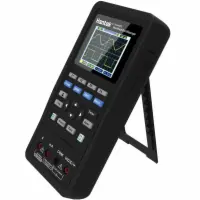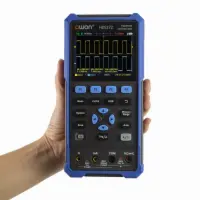Oscilloscope Multimeters
Filters
Filters
Oscilloscope Multimeters
Oscilloscope Multimeters combine the capabilities of a multimeter, which provides precise numerical readings of voltage and other electrical properties, with that of an oscilloscope, which graphically displays how voltage signals change over time. When used in tandem, oscilloscope multimeters can provide a comprehensive picture of the electrical behavior under test.
Oscilloscope multimeters are usually more portable and cost-effective than purchasing a multimeter and oscilloscope separately. Compact, lightweight, and battery-powered, these combination scopes are often designed for on-the-go troubleshooting and field applications where carrying two separate instruments would be inconvenient or impossible.
The versatile oscilloscope multimeter is especially popular among hobbyists, students, and fieldwork professionals who want a portable, budget-friendly, multifunctional scope that streamlines their testing.
- Versatile and Convenient: An oscilloscope with multimeter functionality offers the convenience of two essential tools in one compact device. For anyone who frequently requires both waveform observations and precise electrical measurements, these combination scopes are indispensable.
- Portable: Oscilloscope multimeters are often compact, lightweight, and battery-powered, allowing you to run extensive electrical tests in various locations.
- Space-Saving: These scopes eliminate the need for two separate testing instruments. Also, because oscilloscope multimeters are designed with portability in mind, many combination scopes are handheld, taking up less workstation and storage space than even just one benchtop instrument, let alone two!
- Cost-effective: By combining oscilloscope and multimeter functionality into one device, users don’t need to invest in and maintain two separate tools.
- Efficient: Multimeter oscilloscopes streamline electrical testing, making it easy to switch between numerical measurements and waveform analysis without the need for multiple instruments or set-up changes.
- Limited Performance and Functionality: Compared to standalone multimeters and oscilloscopes, combination scopes might have a lower bandwidth, sampling rate, or resolution. They may not offer as many functions or measurement capabilities as independent instruments. Always check specifications before purchasing to ensure the combination scope is a good fit for what you plan to test.
- Complex User Interface: Operation may be tricky at first as you learn how to switch between modes and navigate all the settings. The user interface may be more challenging for beginners who aren’t already familiar with how a multimeter or oscilloscope works.
No, oscilloscopes and multimeters are not the same. While they are both used for electrical testing, each instrument provides different types of information about electrical performance.
Multimeters excel at providing precise numerical values for specific electrical properties like voltage, current, resistance, inductance, and capacitance. They do not, however, show how all of these properties interact or behave over time. This is where the oscilloscope becomes valuable.
Oscilloscopes provide a waveform that visually illustrates how voltage signals vary over time, helping users understand the shape, frequency, amplitude, and timing of the signal. However, the waveform does not show exact values for resistance or other electrical properties that may be influencing the voltage signal.
One way to understand the difference between the two instruments is to use a musical analogy. The information an oscilloscope provides is like the visual representation of a song, demonstrating how sound waves transform over time. The multimeter is like sheet music, providing precise information about the notes, rhythm, and other musical properties.
Although oscilloscopes are powerful measuring instruments, they cannot do everything that a multimeter can. Multimeters provide precise numerical values for voltage, current, resistance, capacitance, and other electrical properties, whereas oscilloscopes can only graphically display the amplitude, frequency, and timing of a voltage signal over time.
While the vertical axis of the oscilloscope waveform provides voltage measurements, these readings are typically not as precise as a multimeter, which can provide the exact numerical value of the voltage at any given time.
Oscilloscopes can indicate and isolate where issues with the circuit’s signal and performance are occurring, and multimeters can provide precise readings for parts of the circuit (like the resistance or capacitance) that may be causing problems.




